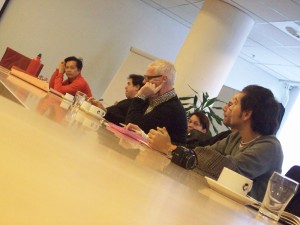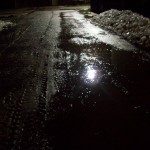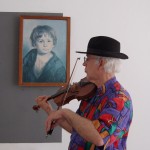No, this is not a picture made on one of Jupiters moons. This is taken…
Epistemic Encounters

Went to an expert meeting yesterday, “Epistemic Encounters’, organised by the Utrecht Consortium. Talks and discussions about the role of the graduate art school when educating ‘knowledge producing artists’. With contributions of Hito Steyerl (Berlin), Tom Holert (Vienna), Jan Kaila (Helsinki), Chris Wainwright (London), Mick Wilson (Dublin) and Marquard Smith (London) it was sure to be interesting.
Again – more insights into the inner workings of the art (education) world. Most of us students were there, also our teachers. On the pic I posted you see Tiong on the left, then Mick Wilson from Dublin, then Klaas, then Chris Wainwright’s profile, then fellow student Leonardo. Discussion was about the nature of ‘knowledge’ and ‘artistic knowledge’, and about what happens when art schools position themselves within academia by asserting themselves as places of research.
I have blogged about the links and disparities between artistic and scientific research before, see ‘Popper, Newton and dwarves on the shoulders of giants‘. I cannot say I kept up with all of the discussion yesterday, my mind being busy with the upcoming review (see blog ‘Tractie Review’) but I did manage to ask a question about constituting an artistic ‘body of knowledge’, which I think is pertinent in the context of the artist as knowledge producer. No clear answer emerged, it is a pretty difficult question of course in a culture that reveres the individuality and originality of artists. Jeremiah Day questioned, in the nicest possible way, the whole idea of the artist as a knowledge producer – where did the idea originate and why should we embrace it today. He was also the one that, in a tutorial I had with him, named Henk Slager’s idea of the artistic researcher being in the same position as someone solving mathematical problems. This I find interesting: curiosity in mathematics – basically: playing with numbers – and following ones artistic curiosity do seem to have a lot in common.
Met with Katalin Herzog and Edith Doove in the intermission, they gave me a few pointers as to material that can be relevant to my question. Katalin used to work for the Groningen University and taught modern art theory at the Frank Morh Institute. She has an interesting weblog (dutch). Edith is head of ed.projects and is currently curating Parallellepipeda – Project on the exchange between art and science – for the City of Leuven. She has helped organise research labs where artists and scientists work together. This is interesting stuff! Results of these research labs will be shown during an exhibition at the new art space M at Leuven from end of January 2010 onwards. Edith promised me an invitation and I hope to be able to talk with her again.
Katalin suggested I read her Show me the Moves, Essays for the MFA Painting of the Frank Mohr Institute, Groningen 2005 and ‘Interpretation and over-interpretation’ by Umberto Eco. Edith named ‘Artscience: Creativity in the Post-Google Generation’ by David Edwards. So: lots more reading to do under the christmas tree.
By the way – an epistemic encounter is a knowledge-yealding experience that is a source for new ideas (see Maynard Adams). Sensory perception is the most commonly accepted type of epestemic encounter. To be an epistemic encounter, a person’s experience of the world must not only provide something new, it must also involve the person’s being correct in taking something to be the case and having good reasons for taking it to be correct. An epistemic encounter has to be conceptualised and articulated correctly.
| « Tractie Review | <-- previous post | next post --> | Research essay » |
|---|







